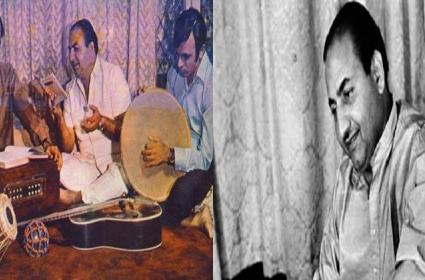If You Are A Mohammed Rafi Fan, You Must Know This!

Ravi Valluri
The year was 1980. Mrs Indira Gandhi, after a political exile of two years, stormed back into the corridors of power. Her son Sanjay, infamous for the excesses of sterilisation during the tenebrous days of the emergency succumbed to an ill fated plane crash. The baton of the dynasty was passed on to the reluctant older son, Rajiv Gandhi.
It was in many ways a tumultuous year. Brawny Soviet Union trampled all democratic norms and their tanks stormed into Afghanistan. This incident triggered large scale boycott of the Summer Olympics at Moscow led by the United States of America.
Later that year came the revelations of the flagitious case of Bhagalpur blindings, immortalised years later by Prakash Jha’s iconic film Gangajal.
All these events however, were overshadowed in the collective memory. On the 31of July that year as it poured heavily in Delhi and motley crowds sat sipping steaming cups of tea, glued to their radio sets, they heard about the tragic demise of the estimable playback singer of Hindi cinema— the one and only mellifluent Mohammed Rafi. The skies darkened and there was a heavy downpour as the elements too seemed to shed tears in his memory.
It was a frosty and nippy winter in Kotla Sultan Singh, a verdant hamlet in the undivided Punjab of British India. The year was 1924 and just a day prior to Christmas, when the charismatic vocalist Mohammed Rafi was born to Haji Ali Mohammad and Allahrakhi Bai. The prodigious child was the fifth of the six siblings.
The child’s musical prowess was revealed from a very tender age and his talent was recognized by his elder brother’s friend Abdul Hameed. This friend prevailed upon Mohamed Rafi’s family to nurture the amateur’s talent.
Mohammed Rafi first learnt the craft of Hindustani classical music under the tutelage of Pandit Jiwan Lal Mattoo. Panditji taught him various intricacies of raag shastra and the strains of Punjabi folk ragas besides imparting him the esoteric knowledge of raagas like Pahaadi, Bhairavi, Basant and Malhaar.
He later trained under Ustad Abdul Wahad Khan of the Kirana Gharana and also received rigorous lessons from the legendary Ustad Bade Ghulam Ali Khan of the Patiala Gharana that further honed his musical skills.
Rafi Saheb, as he was known among the music fraternity was to subsequently polish his metier under the renowned musicologist, Feroze Nizami, a producer with the All India Radio, Lahore.
Legions of Rafi Saheb’s followers are perhaps unaware that K.L. Saigal and G.M. Durani were his idols and in the nascent stages of his career he emulated Saigal’s style of rendition.
Mohammed Rafi performed his first stage show as a young boy of 13 in Lahore. The singer then embarked upon his musical odyssey by rendering for the All India Radio in Lahore in the year 1941.
Then arrived the momentous occasion when he soulfully sang ‘Soniye Nee, Heeriye Nee,’ a duet with the fabled singer, Zeenat Begam for the Punjabi film Gul Baloch. However, it is quite a travesty that the film was screened three years later that is the year 1944.
Mohammed Rafi’s maiden foray in the tinsel world of Hindi cinema was with the magical wand of Naushad. The number was ‘Hindustan Ke Hum Hain’ along with Shyam Kumar, Alauddin and others, in A. R. Kardar's film Pehle Aap. It so happened that around the same time, the talismanic vocalist recorded another song for the 1945 film Gaon Ki Gori, ‘Aji Dil Ho Kaaboo Mein.’ As it was his first solo number, the eminent singer considered it to be his first Hindi song.
Mohammed Rafi has been considered as one of the most versatile singers produced in the subcontinent. Quite seamlessly he could sing romantic, patriotic, classical or melancholic numbers; bhajans, quawallis or peppy beats, the virtuoso singer could do wonders.
Perhaps the singular quality he was known for was his unique ability to mould his voice to the persona and style of the actor —ranging from Dilip Kumar, Dev Anand, Rajendra Kumar to Shammi Kapoor— on the silver screen, with astonishing ability. The lip-syncing matched the performance of the actor.
Rafi Saheb recorded round 7,500 songs during his career and was feted with six Filmfare Awards and one National Film Award, among others. For his gargantuan contribution to Indian cinema the maestro was honoured with the Padma Shri by the Government of India in the year 1967.
The sonorous rendition of “Bhagwan Bhagwan, Ae Duniya Ke Rakhwale, Suno Dard Bhare Mere Nale,” is a reflection of the pluralism and secularism of this country. The magical number which moistens the eyes of cine goers to this day is from the celebrated film Baiju Bawra. The song was picturised on Bharat Bhushan and the lyrics were penned by Naushad Ali and Shakeel Badayuni.
The Voice of the Millennium, Lata Mangeshkar was to once remark, “As a singer you have to bring soul to the song.” Certainly, Mohammed Rafi who sang with all zest, ebullience and gusto succeeded in doing just that…..effortlessly.
Also Read: Mohammed Rafi’s Son Slams Karan Johar
Also Read: Google Doodle On Legendary Singer Md. Rafi’s Birthday




















